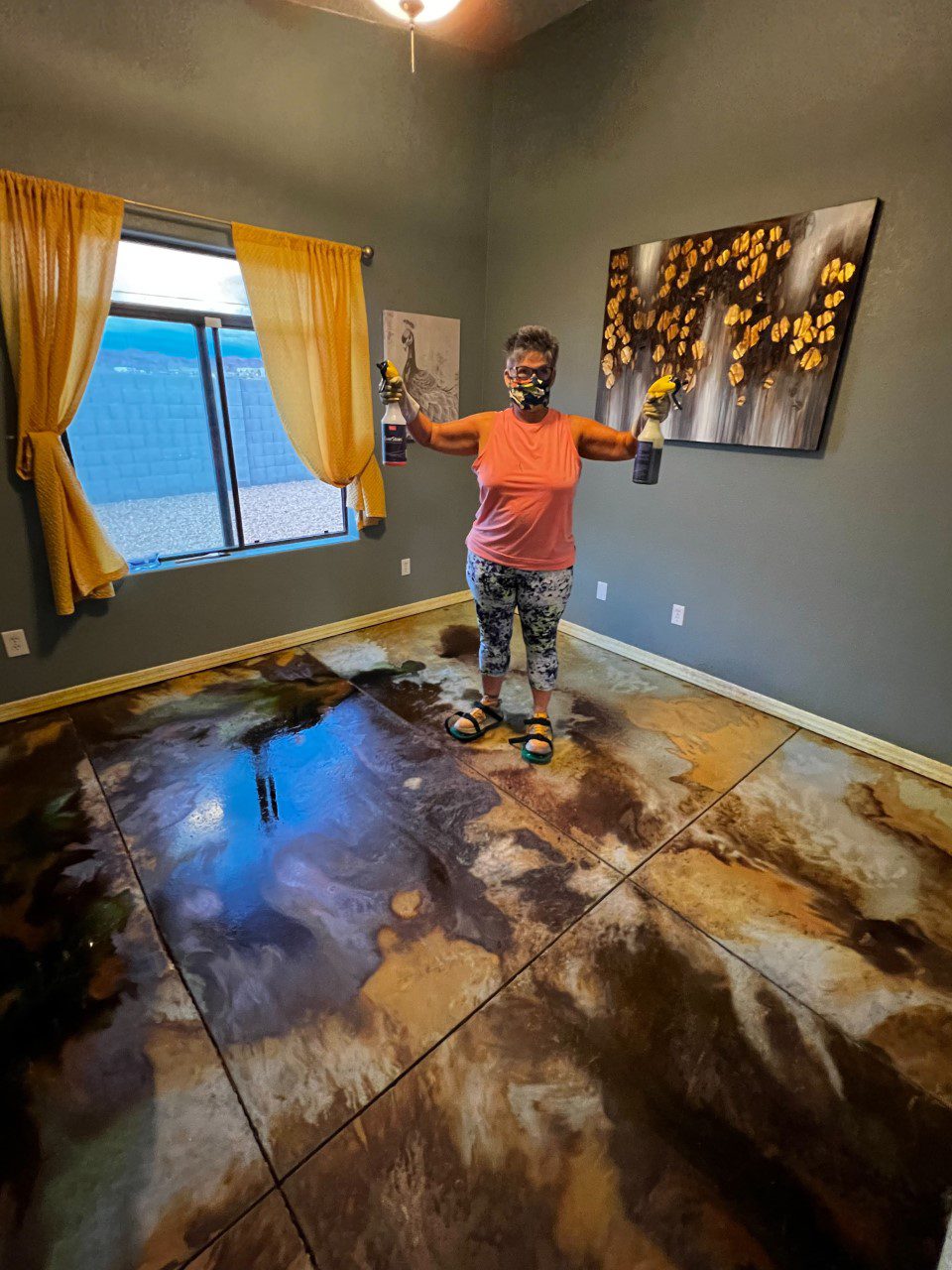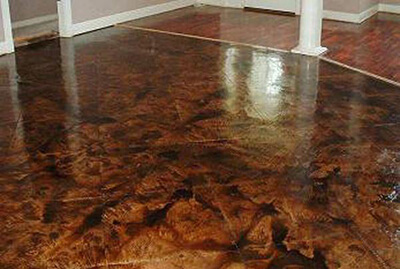All About Stained Concrete: A Comprehensive Overview to Its Advantages and Applications
Stained concrete has actually become a popular selection for both household and commercial spaces. Its ability to incorporate aesthetic charm with usefulness makes it a fascinating option. Various staining methods supply a variety of colors and finishes, permitting customization. The benefits prolong beyond look. Recognizing its applications and maintenance requirements is important for any individual considering this functional material. The nuances of stained concrete welcome further expedition.
What Is Stained Concrete?

Discoloration can be related to numerous surfaces, consisting of floors, driveways, and outdoor patios, making it a versatile choice for both interior and outside areas. The therapy can achieve a variety of appearances, from earthy tones to bold, modern-day designs. Unlike paint, stained concrete preserves its look over time, as it comes to be an indispensable component of the concrete itself. In general, stained concrete offers as an efficient approach for transforming regular concrete right into visually striking surfaces.
Benefits of Stained Concrete
Stained concrete deals considerable advantages, specifically in aesthetic allure and durability - stained concrete. Its lively shades and distinct patterns enhance the aesthetic appeal of any area, making it a popular option for both domestic and industrial applications. In addition, the longevity of stained concrete warranties that it stays a functional financial investment with time, resisting wear and tear
Visual Charm
Among the most compelling advantages of using stained concrete is its remarkable visual appeal. Stained concrete deals a special and versatile appearance that can enhance different design styles, from modern-day to rustic. The infusion of vibrant shades and detailed patterns permits homeowners and designers to create tailored surfaces that can enhance the general atmosphere of an area. Unlike standard flooring alternatives, stained concrete can resemble the appearance of all-natural rock or sleek marble, giving an upscale look without the associated costs. In addition, the glossy finish choices can mirror light, additional brightening insides. This flexibility makes stained concrete a favored choice for both household and commercial applications, where visual influence is vital.
Sturdiness and Long life
The excellent visual qualities of stained concrete are complemented by its amazing sturdiness and long life - stained concrete company. Stained concrete surface areas are resistant to damage, making them suitable for high-traffic areas both inside and outdoors. Their robust nature indicates they can hold up against severe weather condition problems, including extreme temperature levels, rainfall, and UV exposure, without substantial destruction. Furthermore, stained concrete calls for marginal upkeep compared to other flooring options, as it does not require regular sealing or redecorating. This longevity not just reduces substitute costs however additionally adds to a sustainable building method. In general, stained concrete offers an enduring remedy that integrates visual appeal with sensible benefits, guaranteeing its worth in time
Different Types of Staining Methods
Various staining methods can markedly impact the visual top qualities of concrete surface areas. The three key techniques consist of acid staining, which responds chemically with the concrete, water-based staining, which offers a broader variety of shades, and overlay staining choices that give a fresh surface area. Each technique has distinct features and applications that satisfy different style preferences and project needs.
Acid Staining Method
Exactly how can property owners transform ordinary concrete surfaces into visually striking attributes? One effective method is acid discoloration, a popular method that boosts the natural beauty of concrete. This process entails using a solution of water, hydrochloric acid, and metallic salts to the concrete surface area. As the acid reacts with the lime present in the concrete, it produces abundant, variegated shades that resemble marble or rock. Acid staining is known for its resilience and resistance to fading, making it a resilient choice for both indoor and exterior applications. It is necessary to note that the outcomes can vary based on the original concrete shade and appearance. Appropriate application and sealing are essential for accomplishing the wanted visual and durability
Water-Based Staining Technique
A popular option to acid discoloration, the water-based staining strategy provides house owners a functional way to improve concrete surfaces. This technique uses water-soluble dyes and pigments, permitting a broad range of colors and finishes. Unlike acid stains, water-based discolorations can be applied to unsealed concrete and use a simpler cleanup process. The results can accomplish a more uniform appearance and can be layered to develop one-of-a-kind effects. In addition, water-based stains are generally less harmful and produce fewer unstable natural substances (VOCs), making them much more ecologically friendly. Home owners might appreciate the ability to tailor their concrete surfaces with numerous tones, enabling creative expression while maintaining toughness and longevity in their flooring options.
Overlay Discoloration Options
Numerous overlay discoloration options exist for house owners aiming to renew their concrete surfaces. One prominent selection is acid staining, which responds chemically with the concrete to generate rich, variegated shades. An additional alternative is water-based discoloration, providing a wider shade scheme and simpler application. In addition, concrete overlays can be integrated with patterns for complex designs, boosting visual appeals. For a more distinctive finish, homeowners may consider making use of stamped overlays that imitate natural materials like stone or ceramic tile. Each method gives unique benefits, from toughness to personalization, enabling an individualized touch. Ultimately, the option of overlay staining depends on the preferred look and the condition of the existing concrete, guaranteeing a revitalized and attractive surface area.
Applications of Stained Concrete
Stained concrete offers a flexible solution for various applications, improving both aesthetic charm and functionality. This material is generally utilized in residential, business, and industrial setups, making it a popular selection amongst designers and designers. In homes, stained concrete can work as fashionable floor covering or outdoor patios, supplying an innovative look while remaining long lasting.
In commercial spaces, such as stores and restaurants, stained concrete adds to a modern-day ambiance and can withstand hefty foot website traffic. In addition, stained concrete is progressively made use of in public spaces like parks and sidewalks, where its ability to resemble all-natural stone or other materials adds aesthetic passion.
Moreover, stained concrete is ideal for pool decks and driveways, using a slip-resistant surface area that is simple to keep. In general, the adaptability of stained concrete makes it suitable for various atmospheres, catering to varied preferences and demands.
Maintenance and Look After Stained Concrete
Proper upkeep assures the durability and charm of stained concrete surface areas. Routine cleaning is crucial; using a mild cleaning agent and water with a soft-bristle brush assists get rid of dust and crud without damaging the coating. It is advisable to stay clear of rough chemicals that can remove the discolor or sealer.
Securing stained concrete is vital for protection versus moisture, discolorations, and wear. A top notch sealer should be reapplied every one to 3 years, depending upon the web traffic and direct exposure the surface area withstands. Additionally, attending to spills immediately will prevent discoloration and Source staining.

Price Considerations for Stained Concrete Projects
When preparing a tarnished concrete job, budget plan factors to consider play a crucial role in determining the overall expense. The costs related to stained concrete can vary substantially based upon several variables. The dimension of the location to be stained directly influences product and labor costs. Larger spaces will naturally require more sources. Second, the sort of discolor selected-- acid-based or water-based-- can affect pricing, with acid spots commonly being extra expensive. Additionally, the complexity of the style, consisting of patterns or several colors, can boost labor prices. Preparation work, such as cleaning and grinding the concrete surface, includes to the first expenditures. The option in between Do it yourself installation and hiring a specialist specialist will certainly better influence the budget. Understanding these factors makes it possible for home owners to make educated monetary choices concerning their stained concrete projects, ensuring they attain the preferred visual within their financial methods.
Tips for Picking the Right Stained Concrete for Your Space
Choosing the appropriate stained concrete for a specific area entails mindful contemplation of numerous elements beyond just budget. Initially, one should examine the desired use the location. High-traffic areas may call for even more sturdy surfaces, while attractive applications can focus on aesthetics.
The color scheme is one more essential aspect; the picked shades ought to integrate with existing decor and lights. It's also important to consider the surface structure, as smooth coatings can improve sophistication, while distinctive options may ensure security in wet areas.
Neighborhood environment and ecological conditions play a substantial function in the long life and maintenance Homepage of stained concrete, affecting the selection of sealers and finishes.
Finally, speaking with specialists can provide useful insights tailored to details needs, ensuring the option of the excellent stained concrete that straightens with both functionality and style.

Frequently Asked Inquiries
Can Stained Concrete Be Applied Over Existing Floor Covering?
Stained concrete can without a doubt be applied over existing floor covering, gave the surface is steady and appropriately prepared. This technique permits for an aesthetic upgrade without the need for total removal of the initial floor covering products.
The Length Of Time Does Stained Concrete Last?
Stained concrete can last for decades when appropriately kept. Factors such as web traffic, environmental conditions, and application strategies greatly influence its durability, with several setups continuing to be vibrant and intact for 10 to thirty years.
Is Stained Concrete Slippery When Damp?
Stained concrete can be slippery when damp, as the finish might develop a smooth surface. Using non-slip additives or textured finishes can alleviate this issue, improving safety and security without jeopardizing the visual appeal of the concrete.
Can I Discolor Concrete Myself, or Should I Work with a Professional?
The decision to tarnish concrete personally or employ a specialist hinges on skill degree and task complexity. While DIY discoloration can save cash, professionals guarantee excellent results, particularly for detailed designs or large surfaces.
What Color styles Are Readily Available for Stained Concrete?
The variety of colors offered for stained concrete consists of natural tones like browns and tans, vivid shades such as reds and blues, and softer shades like pastels. This combination enables imaginative, tailored layout options.